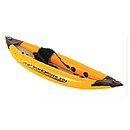This looks like a great dive kayak but they don't make them anymore...
View attachment 173479
Anyone know of something similar? To me, this would be a good solution for what I want.
I have a couple of Sevylor RX-1s (high quality whitewater inflatable kayaks). They will each carry the gear for a one-tank dive. Might even be able to carry a second tank. Very stable. My concern is the effect of wind on paddling. i'll let you know how well they work if I actually use them for diving this weekend. A lot will depend on the conditions at Pt. Lobos.
With any inflated floor stiffness is an issue. Drop stitched floors (like my newer RX-1) are very stiff, tube inflated floors (like my older RX-1) aren't nearly so stout and the paddling is much harder.




